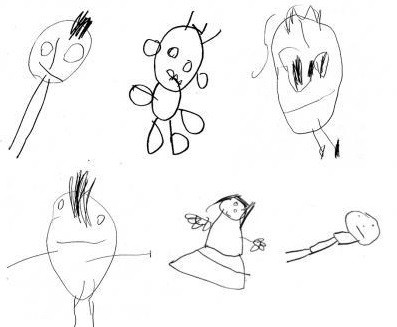Four-Year-Old Children's Drawings Indicate Intelligence in Teenage Years

The drawing ability of a four-year-old child could be an indication of their intelligence a decade later, new research shows.
Researchers at Kings College London found children who produced the best drawings frequently scored highly on verbal and non-verbal intelligence tests carried out at the time, as well as at the age of 14.
The quality of a child's creative efforts is also linked to genes associated with intelligence, according to the study.
The team studied a total of 15,504 children - 7,752 pairs of identical and non-identical twins - from the Medical Research Council funded Twins Early Development Study.
At the age of four, children were asked by their parents to undertake a "Draw-a-Child" test, where the child would be scored on the correct number of features and body parts, such as eyes and arms.
The pictures were scored between zero and 12 and the rating system ignored qualities such as "charm" and "expressed emotion".
The researchers found that higher scores on the Draw-a-Child test were moderately associated with higher scores of intelligence at ages four and 14.
Lead author Dr Rosalind Arden told Science 2.0: "The Draw-a-Child test was devised in the 1920's to assess children's intelligence, so the fact that the test correlated with intelligence at age four was expected."

"What surprised us was that it correlated with intelligence a decade later," she added.
However, the researchers insisted parents of children who lack artistic skills should not worry as drawing ability does not determine intelligence, but a wide range of factors.
"The correlation is moderate, so our findings are interesting, but it does not mean that parents should worry if their child draws badly. Drawing ability does not determine intelligence, there are countless factors, both genetic and environmental, which affect intelligence in later life."
The teams also measured the heritability of figure drawing. Identical twins share all their genes, whereas non-identical twins only share about half, but each pair will have a similar upbringing, family environment and access to the same materials.
Overall, at age four, drawings from identical twins pairs were more similar to one another than drawings from non-identical twin pairs.
Therefore, the researchers concluded that differences in children's drawings have an important genetic link. They also found that drawing at age four and intelligence at age 14 had were strongly linked by genetics.
"This does not mean that there is a drawing gene – a child's ability to draw stems from many other abilities, such as observing, holding a pencil etc," Dr Arden told the Daily Telegraph. "We are a long way off understanding how genes influence all these different types of behaviour."
"Drawing is an ancient behaviour, dating back beyond 15,000 years ago. Through drawing, we are attempting to show someone else what's in our mind," she added.
"This capacity to reproduce figures is a uniquely human ability and a sign of cognitive ability, in a similar way to writing, which transformed the human species' ability to store information, and build a civilisation."
The research was published in Psychological Science.
© Copyright IBTimes 2024. All rights reserved.







